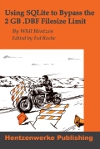|

Table of Contents
Sample Chapters (none)
Downloads
Updates, FAQs & Errata
|
By: Whil Hentzen
Edited by: Ted Roche
ISBN: 978-1-930919-76-1
Length: 106 pages
Formats Available: Printed, Ebook only
Printed book format: Paperback 6x9
Ebook format: PDF (750 K)
Price ($US): 19.95 (printed+ebook) $10.00 (ebook)
Weight: 1.0 lbs.
Press date: September, 2015
Printed book availability: N/A
Ebook availability: Complete & Ready for Download
Source code: (None)
The .DBF file format has been a standard for desktop applications for over 30 years. Pretty much every application can read and write to some sort of .DBF file. Back in the day when it was created, the days of 180 kb floppies, sometime later surpassed by those 1.2 MB 3 1/2 inch disks, and, eventually those monster hard disks that held hundreds of or even a thousand megabytes, the 2 GB limit was not a concern.
The xBase family of tools is an excellent tool for manipulating data, just as a spreadsheet is an excellent tool for manipulating numbers. One use was to import data from other formats, such as text files, and slice and dice it once stored in a .DBF. Over the past decade, though, it's become commonplace to run into data sets in other formats bump up against the 2 GB limit, both due to accumulation of data over decades of use of an application as well as larger and more expansive applications. Often those files are simple text dumps from a large SQL database.
Once they grow larger than two gigabytes, though, dealing with them on a desktop level becomes a problem, since they can't be directly imported into a DBF.
What is needed is an intermediate mechanism that can import a raw text file of any size and then allow the user to slice and dice the data as needed. Enter SQLite.
|





